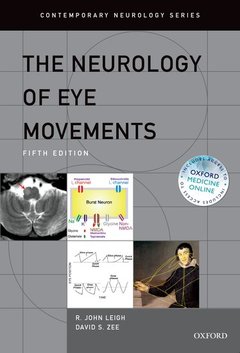The Neurology of Eye Movements (5th Ed.) Contemporary Neurology Series
Langue : Anglais
Auteurs : Leigh R. John, Zee David S.

This new edition of Leigh and Zee's Neurology of Eye Movements is available as an enhanced edition for the first time. Your purchase of the print version includes access to the online version via Oxford Medicine Online. By activating your unique access code, you can discover more than 200 videos, view and enlarge nearly 250 high resolution images, and annotate the work for future personal reference. The Neurology of Eye Movements, edition 5 has two interrelated parts. The first comprises a modern synthesis of the anatomical, physiological, and pharmacological substrate for eye movements, including current views on the reflexive and voluntary control of gaze. This synthesis is based on electrophysiological and inactivation studies in macaque, and behavioural studies in humans that incorporate functional imaging and transcranial magnetic stimulation (TMS) in normals, and clinicopathological studies in patients with neurological, visual, or vestibular disorders. Sophisticated experimental paradigms have been applied to both species to explore aspects of cognition, memory, volition, and reward. This large body of research has demonstrated the power of eye movements as experimental tools. The second part of the book applies this synthesis to the clinical and laboratory evaluation of patients with abnormal eye movements due to a broad range of disorders - from muscular dystrophy, and genetic disorders, to dementia, including visual and vestibular conditions. By placing links to figures, tables, boxes, and videos, a synthesis of basic research and clinical findings is provided, that may shed new light on disease processes and provide insights on normal brain function.
Neurologists, ophthalmologists, otolaryngologists, optometrists,
neuroscientists, biomedical engineers, psychologists, computation
biologists
Dr. Leigh, who trained in neurology at the University of Newcastle-upon-Tyne, Cornell Medical Center in New York, and the Johns Hopkins Medical Center in Baltimore, has applied eye movements to study a broad range of disorders affecting the brain, eye, or ear during his career as a clinician-scientist. He has served on review committees of the National Institutes of Health and on the editorial boards of journals Annals of Neurology and Neurology. His collaboration of over 35 years with Dr. Zee has produced many joint publications including five editions of the Neurology of Eye Movements. Dr. Zee first came to Johns Hopkins in Baltimore in 1965 as a medical student and then trained there in neurology after an internal medicine internship at Cornell Medical Center in New York. Both his research and clinical focus has been on eye movement and vestibular disorders. He has had three sabbatical years at the National Eye Institute in their Laboratory of Sensorimotor Research. He first began working with Dr. Leigh in the late 1970s when Dr. Leigh was at Hopkins as a fellow and then a faulty member.
Date de parution : 08-2015
Ouvrage de 1136 p.
18.4x24.9 cm
Thèmes de The Neurology of Eye Movements :
© 2024 LAVOISIER S.A.S.



